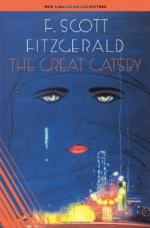|
This section contains 1,351 words (approx. 5 pages at 300 words per page) |

|
SOURCE: Sutton, Brian. “Fitzgerald's The Great Gatsby.” Explicator 59, no. 1 (fall 2000): 37-9.
In the following essay, Sutton examines the significance of a recurring image of the framing of Tom and Daisy in a frame of artificial light in Gatsby.
In F. Scott Fitzgerald's The Great Gatsby, Gatsby goes to spectacular lengths to try to achieve what Nick Carraway calls “his incorruptible dream” (155): to recapture the past by regaining Daisy Buchanan's love and getting her to tell her husband, Tom, that she never loved him (111). For much of the novel, Gatsby seems likely to succeed, not only because his efforts are so extraordinary, but because Daisy's marriage seems so miserable and corrupt that she must surely be looking for the chance to escape. But Daisy herself proves to be corrupt and thus perfectly suited for marriage with Tom, with whom she shares membership in an exclusive society from which Gatsby...
|
This section contains 1,351 words (approx. 5 pages at 300 words per page) |

|


